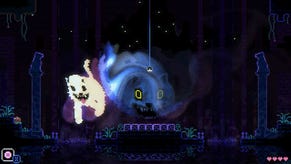MAG
The future of the multiplayer shooter?
And with play-style Zipper's watchword, again, is freedom. The three classes aren't strictly defined, so you can build a hybrid character if you want; and you've always got the opportunity to switch between three loadouts when respawning. These are your standard assault trooper with good healing abilities (you heal yourself and others by firing a cloud of health from a sort of first-aid gun, the most science-fiction element in this otherwise sensible near-future scenario); a sniper-scout with a self-heal; and a heavy assault loadout with machinegun, rocket launcher and "repair gun" for equipment and installations, but no player healing.
Spawn points are pushed backwards and forwards with the frontlines of battle, and are wonderfully dynamic. Some are just bunkers, but others might be an APC or helicopter for insertion behind enemy lines (and use as defensive firing platforms). Or there's what will surely be MAG's visual signature, the paratrooper drop; waves of dozens of respawning players, guiding themselves down from the sky into the thick of battle, and if they're really unlucky, being picked off by snipers before they get boots on the ground. Die, and there's a "bleedout" grace period before you respawn, during which a friendly player can bring you back to life, although you can always opt out of this if you feel like switching roles.
Unlike other large-scale multiplayer shooters - the Battlefield series and Enemy Territory: Quake Wars spring to mind - MAG surprisingly eschews player-controlled vehicles beyond those APCs. "Vehicles, especially fast vehicles with long ranges, require a lot of space. What we wanted to do was make sure our maps were densely populated, were massive, but weren't of a scale where players were running a lot to get into combat, or shooting from a very large distance."
It's a very smart decision. MAG's scale is all about people, not space. It's about seeing dozens of players by your side, dozens more in the distance, and hearing the widespread rattle of gunfire and the distant (or not-so-distant) screen-shaking thunder of airstrikes. Above all, it's about knowing that not one piece of this staggering spectacle, on a par with the grandest Call of Duty set-piece, is scripted or AI-directed. Every bullet, every explosion, every scrambling figure is the action of a real live player.

The maps, then, are large but not too open, throwing players together as much as possible; they're a logical extension of the map design for a standard shooter ("We realised what makes a good multiplayer map makes a good MAG map," Byrne says). They're mostly military complexes. MAG's scenario is a three-way conflict between three private military corporations (PMCs) as they seek to gain advantages over each other in the struggle for government contracts. This will play out in a persistent metagame that players can track from the MAG website.
The three factions differ in style more than anything. Raven, whose futuristic bunkers are found in humid South American hills, are a sleek, high-tech, special-ops operation, all black carbon fibre armour and meticulous hygiene. Valor are grizzled, manly war veterans with a traditional military look, toughing it out in Alaska. S.V.E.R. (pronounced "sever") are edgy, aggressive guerrilla fighters with hoodies, hockey masks and improvised, ramshackle equipment, daubing graffiti all over the abandoned Russian installations they call home.
These environments are drawn in remarkable detail, considering the immense technical demands of running a 256-player battler at a solid 30 frames per second. MAG isn't quite Call of Duty 4 or Killzone 2 in the beauty-pageant stakes, and it has an understated look. But it's sharp, the level of detail is convincing, and abundant use of light-scattering fog and smoke engenders an impressively gritty, war-zone feel. Zipper's coding achievement is quietly immense.

"I think that you might have seen people achieve simply the scale but without the graphical fidelity, or you might have seen people achieve the fidelity but with horrific lag," says Byrne, explaining why we haven't seen the likes of MAG before. "It's daunting, not only in surmounting the obstacle of how do we possibly get that many players and have it run at 30 frames a second, but even once you accomplish that, the inevitable is how do we make it look good, and how on earth do we make it fun?
"I think the trifecta of those obstacles has been something that not many developers have been in a position to overcome. At Zipper we're in a lucky position in that PlayStation 3's actually an amazing piece of kit - we've leveraged the technology to the fullest that we can right now, everything's running on SPUs, the Blu-ray actually allows us to put a lot of content on levels, so we can have a lot of fidelity in graphical environments just from technology alone."
It's nice of Byrne to defer credit to his publishing, platform-holding paymasters. But there's plenty in MAG Sony can't take credit for. The superb tuning and tactile punch of the weapons; the expert finesse of the map design; the relentless pace of the battles; the perfectly-balanced tightrope-walk between order and chaos, between tactical primacy and player freedom. With alpha coming to a close, news of a public beta expected soon and release towards the end of the year, MAG looks fighting-fit already, and PS3 could soon have a multiplayer shooter that will be the envy of all.
MAG is due out exclusively for PS3 in autumn 2009.









